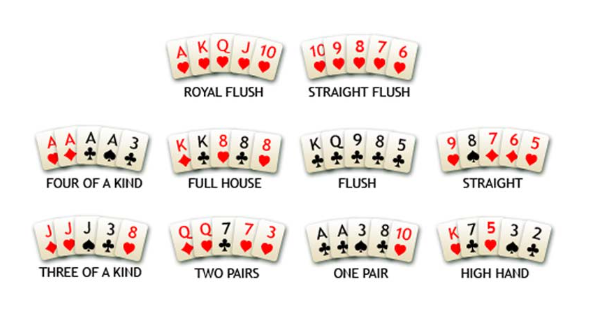An overview of the most popular poker variants
- Texas Hold’em
- Omaha
- Stud
- Razz
- Draw Poker
- Sit & Go
- Draw Poker
- Other increasingly popular variants

Let’s look at an overview of the most popular poker variants
For those new to poker, it might seem that this game has a single format and rules. However, this is far from the case, as poker has several variations. Learning to play all of them or mastering one is the choice of each player. You can try them all and find the one that suits you best. Professionals play only a few games. However, it’s worth examining the most popular poker variants in more detail.
Texas Hold’em
This type of poker is the most popular and widespread in the world. The game begins with pre-flop bets—the big and small blinds—that form the pot. Players are dealt two cards; if they like them, they can try to make a hand using the next five community cards. Cards are dealt gradually over three periods: the flop, turn, and river. These are called betting rounds. Players can perform the following actions:

bet – place a bet;
call – match the bet;
raise – increase the amount;
check – pass the action in the hand;
foul – quit the game, discarding the cards.
Most often, the winner, the one with the strongest hand, is determined at the showdown.
Omaha
This is the second most popular form of poker. The betting is identical to Hold’em. However, the rules for making hands are different.
Yes, there are three: fixed limit, pot limit, and no limit. They differ in pot limits and bet sizes. Players receive four cards (Omaha4), but can only use two to make hands. The dealer places five community cards on the table, of which three can be used to make hands.

There are also (Omaha5) and (Omaha6) – the principle is the same, except that each hand is dealt five and six cards, respectively.
Omaha has a variation (Hi-Lo). Here, the pot is split equally between the players with the highest and lowest hand. The lowest hand can be made up to an eight.
Stud
The rules of this poker format are significantly different. The most common form of 7-card Stud is when the dealer deals two cards face down and one face up. Betting is mandatory. The lowest value of the face up card requires its owner to make a bring-in—either a full or half of the maximum bet. Players receive another face up card after each of the next two rounds. The showdown occurs after the final round of betting, when another face down card is dealt. The flop, turn, and river, which are common in Hold’em, are absent in Stud.
Razz
This is a subset of Stud. The only difference is the way the winner is determined:
an ace is considered a 1 and is the lowest card;
to win, you must make the lowest hand;
there are no flush or straight.
Draw Poker
This type of game is suitable for players who prefer a dynamic and aggressive game. This poker game has its own unique characteristics: the game is played by exchanging cards – after the first betting round, you can discard any number of cards and receive the same number of new cards in return; before the cards are dealt, all players place their bets;
2 to 5 players can participate, each receiving 5 hole cards;
there is no communal table;
There are no restrictions on exchanging: a player can give up all their cards or keep all their poker hands; depending on the game format, 1 to 3 exchanges are allowed.
Sit & Go
This variation of the popular Texas Hold’em is the most common format played in online casinos. It differs from standard tournaments in that the number of participants depends on the announced rules of the particular match. The main difference is that a Sit & Go poker match does not start at a specific time, but rather as soon as the required number of players have registered.
Paid Poker
This is the most unusual form of the game, as it requires counting and recording points. Players can play from 2 to 10 hands, each receiving their cards over several hands and betting after each round. During the betting, players place an order for the number of points they plan to score—they call tricks. The goal of the player is to beat the cards dealt by the previous player during the match. Card ranking in this type of poker is traditional, and points are awarded when all cards are covered. These points are recorded on a special table.
The Spread of Poker: How a Beginner Can Choose a Game
The diversity of poker variations has led to regional differences, with certain formats being more popular in certain countries. For example, in some regions of the United States, no other game is played except Omaha. In Asia, even its own distinct game types have developed.
A beginner can decide on a poker format after studying the theoretical foundation, which is available in open sources. Then, all that remains is to hone their skills in online poker rooms and other sources of practice.
New Poker Formats
Poker fans strive to improve and develop their favorite game. Therefore, new variations with unusual rules are emerging. For example:
Lowball – the rules of this type of poker are identical to Texas Hold’em, with the exception of determining the winner. The winner is the player with the lowest hand.
HORSE – each hand in this game is played according to the rules of one of the popular poker variations. For example, the first hand is Razz, the second is Hold’em, and so on.
Chinese Poker – The dealer deals 13 cards, which players lay out on the board in three piles. The player must make the weakest hand in the bottom pile, the middle hand in the center pile, and the weakest hand in the top pile. The rules of poker don’t require betting, as the game is played for points – points earned if other players’ hands are weaker.
Newer poker variations have not yet gained widespread popularity worldwide, so due to the low level of competition, it’s easier for players to develop their hand and become proficient in this format.